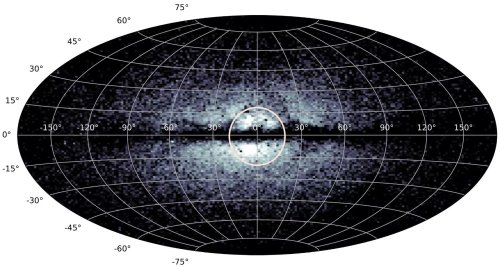Astronomers identify what they think are the Milky Way’s first stars

The concentration of ancient stars in the Milky Way’s core region.
Click for originial image.
The uncertainty of science: Using data produced by the European space telescope Gaia, combined with computer analysis, astronomers think they have identified the Milky Way’s first stars, all located within 30,000 light years of the galaxy’s core region.
The researchers began by locating a sample of two million bright red giant stars with the right spectra, using computer neural network machine learning.
With that sample, it proved comparatively easy to identify the ancient heart of the Milky Way galaxy – a population of stars that Rix has dubbed the “poor old heart”, given their low metallicity, inferred old age, and central location. On a sky map, these stars appear to be concentrated around the galactic center. The distances conveniently supplied by Gaia (via the parallax method) allow for a 3D reconstruction that shows those stars confined within a comparatively small region around the center, approximately 30,000 light-years across
The stars in question neatly complement Xiang’s and Rix’s earlier study of the Milky Way’s teenage years: They have just the right metallicity to have brought forth the metal-poorest of those stars that, later on, formed the Milky Way’s thick disk. Since that earlier study provided a chronology for thick-disk formation, this makes the ancient heart of the Milky Way older than about 12.5 billion years.
While the uncertainties of this scientific result are huge, it still helps identify the beginnings of the Milky Way, its initial size, and the kind of stars that existed here at that time.
On Christmas Eve 1968 three Americans became the first humans to visit another world. What they did to celebrate was unexpected and profound, and will be remembered throughout all human history. Genesis: the Story of Apollo 8, Robert Zimmerman's classic history of humanity's first journey to another world, tells that story, and it is now available as both an ebook and an audiobook, both with a foreword by Valerie Anders and a new introduction by Robert Zimmerman.
The ebook is available everywhere for $5.99 (before discount) at amazon, or direct from my ebook publisher, ebookit. If you buy it from ebookit you don't support the big tech companies and the author gets a bigger cut much sooner.
The audiobook is also available at all these vendors, and is also free with a 30-day trial membership to Audible.
"Not simply about one mission, [Genesis] is also the history of America's quest for the moon... Zimmerman has done a masterful job of tying disparate events together into a solid account of one of America's greatest human triumphs."--San Antonio Express-News

The concentration of ancient stars in the Milky Way’s core region.
Click for originial image.
The uncertainty of science: Using data produced by the European space telescope Gaia, combined with computer analysis, astronomers think they have identified the Milky Way’s first stars, all located within 30,000 light years of the galaxy’s core region.
The researchers began by locating a sample of two million bright red giant stars with the right spectra, using computer neural network machine learning.
With that sample, it proved comparatively easy to identify the ancient heart of the Milky Way galaxy – a population of stars that Rix has dubbed the “poor old heart”, given their low metallicity, inferred old age, and central location. On a sky map, these stars appear to be concentrated around the galactic center. The distances conveniently supplied by Gaia (via the parallax method) allow for a 3D reconstruction that shows those stars confined within a comparatively small region around the center, approximately 30,000 light-years across
The stars in question neatly complement Xiang’s and Rix’s earlier study of the Milky Way’s teenage years: They have just the right metallicity to have brought forth the metal-poorest of those stars that, later on, formed the Milky Way’s thick disk. Since that earlier study provided a chronology for thick-disk formation, this makes the ancient heart of the Milky Way older than about 12.5 billion years.
While the uncertainties of this scientific result are huge, it still helps identify the beginnings of the Milky Way, its initial size, and the kind of stars that existed here at that time.
On Christmas Eve 1968 three Americans became the first humans to visit another world. What they did to celebrate was unexpected and profound, and will be remembered throughout all human history. Genesis: the Story of Apollo 8, Robert Zimmerman's classic history of humanity's first journey to another world, tells that story, and it is now available as both an ebook and an audiobook, both with a foreword by Valerie Anders and a new introduction by Robert Zimmerman.
The ebook is available everywhere for $5.99 (before discount) at amazon, or direct from my ebook publisher, ebookit. If you buy it from ebookit you don't support the big tech companies and the author gets a bigger cut much sooner.
The audiobook is also available at all these vendors, and is also free with a 30-day trial membership to Audible.
"Not simply about one mission, [Genesis] is also the history of America's quest for the moon... Zimmerman has done a masterful job of tying disparate events together into a solid account of one of America's greatest human triumphs."--San Antonio Express-News


Given the uncertainty of science, these are almost certainly NOT the oldest stars in the galaxy